MaryAnn Bernal's Blog, page 248
August 15, 2014
History Trivia - City of Rhodes surrenders to the forces of the Knights of St. John
August 15

778 The Battle of Roncevaux Pass (Pyrenees on the border between France and Spain), at which Roland (commander of the rear guard of Charlemagne's army) was killed. The battle was romanticized by oral tradition into a major conflict between Christians and Muslims, when in fact both sides in the battle were Christian. The legend is recounted in the 11th century The Song of Roland, which is the oldest surviving major work of French literature, and in Orlando Furioso, which is one of the most celebrated works of Italian literature.

982 Holy Roman Emperor Otto II was defeated by the Saracens in the battle of Capo Colonna, in Calabria.

1248 The foundation stone of Cologne Cathedral, built to house the relics of the Three Wise Men, was laid.
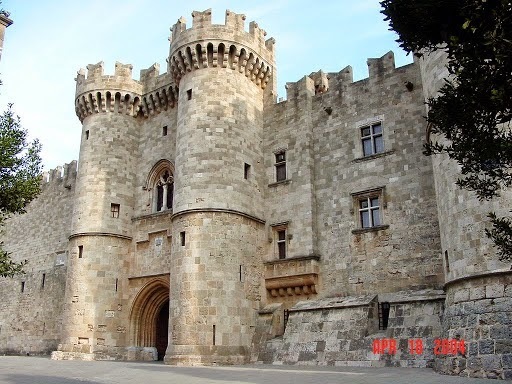
1309 – The city of Rhodes surrendered to the forces of the Knights of St. John, completing their conquest of Rhodes. The knights established their headquarters on the island and renamed themselves the Knights of Rhodes.

1457 "Mainz Psalter," the earliest dated book was completed.

1483 Pope Sixtus IV consecrated the Sistine Chapel.

1548 Mary Queen of Scotland arrived in France.


778 The Battle of Roncevaux Pass (Pyrenees on the border between France and Spain), at which Roland (commander of the rear guard of Charlemagne's army) was killed. The battle was romanticized by oral tradition into a major conflict between Christians and Muslims, when in fact both sides in the battle were Christian. The legend is recounted in the 11th century The Song of Roland, which is the oldest surviving major work of French literature, and in Orlando Furioso, which is one of the most celebrated works of Italian literature.

982 Holy Roman Emperor Otto II was defeated by the Saracens in the battle of Capo Colonna, in Calabria.

1248 The foundation stone of Cologne Cathedral, built to house the relics of the Three Wise Men, was laid.

1309 – The city of Rhodes surrendered to the forces of the Knights of St. John, completing their conquest of Rhodes. The knights established their headquarters on the island and renamed themselves the Knights of Rhodes.

1457 "Mainz Psalter," the earliest dated book was completed.

1483 Pope Sixtus IV consecrated the Sistine Chapel.

1548 Mary Queen of Scotland arrived in France.

Published on August 15, 2014 05:14
August 14, 2014
Here are some of the biggest dinosaur questions still unanswered
 By Neal Colgrass
By Neal ColgrassDinosaur articles, movies, and museum displays are common enough that you might consider all dino-mysteries solved, but the Smithsonian reports that major ones still remain. Among them:
Who was first? Nobody knows which dinosaur species came first, partly because fossil records provide fragmentary insights rather than "the entire reel," notes the Smithsonian.
But skeletons in Tanzania and tracks in Poland tell us that dinosaurs may have started about 245 million years ago—with the slim and "dog-size" Nyasasaurus.Hot- or cold-blooded? Several experts say dinosaurs were hot-blooded, but now some suggest they were "mesotherms," warming their bodies with their muscle activity and experiencing changing body temperatures.Who was biggest? The fossil record isn't clear, but titanic sauropods evolved a few times into huge creatures like the Supersaurus, Diplodocus, and Argentinosaurus, each of which reached about 100 to 110 feet in length.How did they mate? Well, they hatched from eggs.
We assume females had a cloaca—an orifice that functions for reproduction, excretion, and urination in today's crocodiles and birds—and males had an "intromittent organ" found in ostriches and ducks.
But we can't know without clear fossils of the organs.Click for the full list, including the mystery of their "funky headgear," hunting habits, and, of course, how they went extinct.
(Here's one theory on the latter.)
http://www.foxnews.com/science/2014/08/12/here-are-some-biggest-dinosaur-questions-still-unanswered/

Published on August 14, 2014 16:12
Origins of Hierarchy: How Egyptian Pharaohs Rose to Power
By Stephanie Pappas
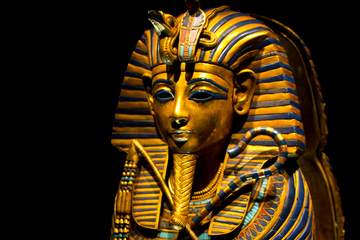
 New research reveals how despots like the rulers of ancient Egypt, including King Tut (represented here), arose to power.
New research reveals how despots like the rulers of ancient Egypt, including King Tut (represented here), arose to power.
Credit: Dmitry Denisenkov, CC Attribution Share-Alike 2.0 Generic.
The rulers of ancient Egypt lived in glorious opulence, decorating themselves with gold and perfumes and taking their treasures with them to the grave.
But how could such a hierarchical, despotic system arise from egalitarian hunter-gatherer societies? The reasons were part technological and part geographical: In a world where agriculture was on the rise and the desert was all-encompassing, the cost of getting out from under the thumb of the pharaoh would have been too high.
"There was basically nowhere else to go," said study author Simon Powers, a postdoctoral researcher in ecology and evolution at the University of Lausanne in Switzerland. "That cost of leaving could basically lock individuals into despotism
From egalitarianism to hierarchy
Ancient Egypt is just one example of a society that transitioned from equality to hierarchy. During the Neolithic Period, often referred to as the Stone Age — which began about 10,000 years ago — agriculture began to replace hunting and gathering as the principal means for obtaining food. At the same time, societies in which everyone had been more or less equal began to schism into classes, with clear leaders emerging. In many cases, these leaders held absolute power.
Many researchers have theorized that agriculture allowed people to hoard food and resources, and that with this power, they could induce others to follow them. But no one had ever convincingly explained how the transition from no leaders to leaders could have occurred, Powers told Live Science. If everyone in hunter-gatherer societies was more or less equal in strength or resources to start, why would they allow an individual to dominate in the first place? [Dictator Deaths: How 13 Notorious Leaders Died]
To find out, Powers created a computer model filled with individuals who had their own preferences for egalitarianism or hierarchy. In the model, as in life, the more resources an individual possessed, the more offspring they could have. In the simulations, populations would sometimes gain a voluntary leader — though the next generation down the line could choose to break off from that leader, at a cost of some resources. (Leaders' children did not defect, given that they stood to inherit their parents' wealth.)
The simulations revealed that voluntary leadership arises when leaders give enough benefits to their followers at the outset, Powers said. If leaders give their people an advantage in producing food, the people will follow them, he added.
From leaders to despots
But leadership turns to despotism when two factors arise. The first is the growth of population density and size, which follows naturally from an organized, agricultural society.
"It basically becomes hard for individuals to stop following the leader," Powers said. "As the density of the population grows, there is less free land available."
This leads to the second factor: a feedback loop. With the benefits of leadership, subjects get more resources and thus are able to have more children. These children increase the population size and density, leading to even less free land and fewer opportunities to leave.
However, if the cost of leaving the group is low — perhaps because there's a friendly city nearby to join, or open land an easy journey away — despotism can't arise. People simply leave when a leader becomes too powerful. When the cost is high — either because of geographical barriers, such as Egypt's desert, or practical ones, such as the need to access to irrigation — people have to put up with more abuse of power from their leaders.
"In hunter-gatherer groups, if an individual tries to behave in a despotic way, then the rest of the group simply gets up in the middle of the night and walks away, but with agriculture that was much less feasible," Powers said.
The findings can explain differences in hierarchy across the Stone Age world. For example, Peru was the site of multiple early states, which evolved in long, fertile agricultural valleys. To leave one of these valleys, people would have had to cross the mountains — a dangerous and difficult undertaking, Powers said.
In contrast, the Amazon basin remained more egalitarian even after the advent of agriculture, likely because it was easier to move around and find suitable land.
Some of these Stone Age rules still remain today. In democratic societies, Powers said, it's easier to kick out a leader, so leaders rarely achieve despotism. In nondemocratic societies, however, leaders can behave in more autocratic ways without fear of losing their perch.
Powers and his adviser Laurent Lehmann, also of the University of Lausanne, reported their findings Aug. 5 in the journal Proceedings of the Royal Society B. The next step, Powers said, is to scale up the model.
"I want to look at what drove the creation of large-scale states from despotic groups," he said.
http://www.livescience.com/47284-how-stone-age-despots-evolved.html


 New research reveals how despots like the rulers of ancient Egypt, including King Tut (represented here), arose to power.
New research reveals how despots like the rulers of ancient Egypt, including King Tut (represented here), arose to power.Credit: Dmitry Denisenkov, CC Attribution Share-Alike 2.0 Generic.
The rulers of ancient Egypt lived in glorious opulence, decorating themselves with gold and perfumes and taking their treasures with them to the grave.
But how could such a hierarchical, despotic system arise from egalitarian hunter-gatherer societies? The reasons were part technological and part geographical: In a world where agriculture was on the rise and the desert was all-encompassing, the cost of getting out from under the thumb of the pharaoh would have been too high.
"There was basically nowhere else to go," said study author Simon Powers, a postdoctoral researcher in ecology and evolution at the University of Lausanne in Switzerland. "That cost of leaving could basically lock individuals into despotism
From egalitarianism to hierarchy
Ancient Egypt is just one example of a society that transitioned from equality to hierarchy. During the Neolithic Period, often referred to as the Stone Age — which began about 10,000 years ago — agriculture began to replace hunting and gathering as the principal means for obtaining food. At the same time, societies in which everyone had been more or less equal began to schism into classes, with clear leaders emerging. In many cases, these leaders held absolute power.
Many researchers have theorized that agriculture allowed people to hoard food and resources, and that with this power, they could induce others to follow them. But no one had ever convincingly explained how the transition from no leaders to leaders could have occurred, Powers told Live Science. If everyone in hunter-gatherer societies was more or less equal in strength or resources to start, why would they allow an individual to dominate in the first place? [Dictator Deaths: How 13 Notorious Leaders Died]
To find out, Powers created a computer model filled with individuals who had their own preferences for egalitarianism or hierarchy. In the model, as in life, the more resources an individual possessed, the more offspring they could have. In the simulations, populations would sometimes gain a voluntary leader — though the next generation down the line could choose to break off from that leader, at a cost of some resources. (Leaders' children did not defect, given that they stood to inherit their parents' wealth.)
The simulations revealed that voluntary leadership arises when leaders give enough benefits to their followers at the outset, Powers said. If leaders give their people an advantage in producing food, the people will follow them, he added.
From leaders to despots
But leadership turns to despotism when two factors arise. The first is the growth of population density and size, which follows naturally from an organized, agricultural society.
"It basically becomes hard for individuals to stop following the leader," Powers said. "As the density of the population grows, there is less free land available."
This leads to the second factor: a feedback loop. With the benefits of leadership, subjects get more resources and thus are able to have more children. These children increase the population size and density, leading to even less free land and fewer opportunities to leave.
However, if the cost of leaving the group is low — perhaps because there's a friendly city nearby to join, or open land an easy journey away — despotism can't arise. People simply leave when a leader becomes too powerful. When the cost is high — either because of geographical barriers, such as Egypt's desert, or practical ones, such as the need to access to irrigation — people have to put up with more abuse of power from their leaders.
"In hunter-gatherer groups, if an individual tries to behave in a despotic way, then the rest of the group simply gets up in the middle of the night and walks away, but with agriculture that was much less feasible," Powers said.
The findings can explain differences in hierarchy across the Stone Age world. For example, Peru was the site of multiple early states, which evolved in long, fertile agricultural valleys. To leave one of these valleys, people would have had to cross the mountains — a dangerous and difficult undertaking, Powers said.
In contrast, the Amazon basin remained more egalitarian even after the advent of agriculture, likely because it was easier to move around and find suitable land.
Some of these Stone Age rules still remain today. In democratic societies, Powers said, it's easier to kick out a leader, so leaders rarely achieve despotism. In nondemocratic societies, however, leaders can behave in more autocratic ways without fear of losing their perch.
Powers and his adviser Laurent Lehmann, also of the University of Lausanne, reported their findings Aug. 5 in the journal Proceedings of the Royal Society B. The next step, Powers said, is to scale up the model.
"I want to look at what drove the creation of large-scale states from despotic groups," he said.
http://www.livescience.com/47284-how-stone-age-despots-evolved.html

Published on August 14, 2014 16:06
Oldest Evidence for Egyptian Mummy Making Discovered
By Megan Gannon
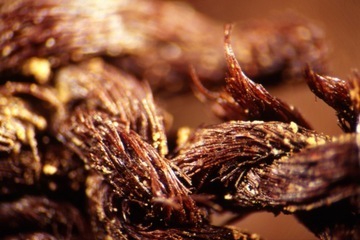
 This resin-saturated flax yarn came from a late Neolithic burial wrapping, found at a grave in Upper Egypt. The sample is now kept at the Bolton Museum in England.
This resin-saturated flax yarn came from a late Neolithic burial wrapping, found at a grave in Upper Egypt. The sample is now kept at the Bolton Museum in England.
Credit: © Ron Oldfield and Jana Jones
Three thousand years before King Tut's body was brushed with embalming oils and wrapped in linen to rest in a gold-filled tomb, prehistoric Egyptians seeking immortality may have experimented with their own recipes to preserve the dead for the afterlife.
Scientists previously thought that mummy making began in Egypt around 2600 B.C., during the era when the pyramids of Giza were built, known as the Old Kingdom. But now scientists say they have found traces of complex embalming agents on much older bits of burial shrouds that had been sitting in a museum for nearly 100 years after they were dug up along the Nile Valley.
The newly examined linens were peeled from bodies buried at the Egyptian sites known as Badari and Mostagedda during the Late Neolithic and Predynastic periods, between 4500 B.C. and 3100 B.C. Archaeologists first found these pit graves during a British expedition to the region in the 1920s, and researchers had previously assumed that the hot, dry desert sand naturally mummified any well-preserved corpses from this era.
The harsh environment definitely encouraged preservation, and may have even inspired mummification practices in the first place. But the new research, detailed today (Aug. 13) in the journal PLOS ONE, suggests Egyptians at that time were cooking up embalming mixtures made from animal fats, as well as tree resins and plant extracts that contained powerful antibacterial elements.
The study "highlights the enormous potential of museum collections accumulated a century ago for giving us new insights into the ancient past," said Alice Stevenson, curator of University College London's Petrie Museum of Egyptian Archaeology, who was not involved in the study.
Recipe for death
Study leader Jana Jones of Macquarie University in Sydney, Australia, and colleagues examined about 50 samples from prehistoric mummy wrappings, mostly taken from tombs at Mostagedda in modern-day Egypt's Asyuti Province. Archaeologists had often noted these textiles, now housed at England's Bolton Museum, looked suspiciously waxy, as if they were covered in resin, said study researcher Stephen Buckley, an archaeological chemist at the University of York in England.
"I thought there may actually be something here," Buckley told Live Science. "I also knew you couldn't tell by looking, because sometimes bodies can produce shiny substances depending on the context they're in. There was very tentative evidence that there might be something interesting there, but not exactly what it was."
These shiny substances were indeed artificial, a chemical analysis showed. In most cases, the recipe consisted of about three-quarters animal fat or oil, mixed with a small amount of pine resin, aromatic plant extract, a sugar or plant gum, and a natural petroleum. The team found chemical signatures of heating, suggesting these substances had been processed in antiquity.
"It was a recipe that was relatively consistent [across all samples], and it was the same recipe, essentially, that was being used later in pharaonic, classical Egyptian mummification," Buckley said.
The tree resin and aromatic plant extract, in particular, have powerful antibacterial properties. Though these elements wouldn't have entirely stopped the decay of the body, they would have at least stopped bacteria from flourishing, Buckley said.
The embalming ingredients also suggest that these prehistoric people had a wide trade network. Some of the compounds were imported far from the heart of Egypt, including the pine resin, which came from southeastern Anatolia, in modern-day Turkey, Buckley said.
Eternal life
Prehistoric Egyptians didn't leave behind embalming manuals or treatises about their views on the afterlife like their descendants did. But these early attempts at mummification may have been the seeds of the Egyptian idea that immortality required the body's preservation, Buckley said. [See Images of Egyptian Mummification Process]
Artificial mummification isn't unique to Egypt. The oldest mummy-making society was the Chinchorro culture in northern Chile and Peru, which has mummies that date back to 6000 B.C. Buckley said it's interesting that most cultures that practiced mummification lived in dry, desert climates, where bodies would be preserved naturally to some extent. He suspects people in these regions may have connected natural body preservation with cheating death, and may have later developed salves to aid in that process.
In Egypt, the choice of embalming agents might have been accidental at first.
"What makes most sense is perhaps these ingredients were chosen for their symbolic significance initially," Buckley said. For example, the team discovered traces of a chemical that's found only in sea sponges in the Mediterranean. These regenerative animals may have held some symbolic significance related to rebirth.
"They likely noticed that there was some soft-tissue preservation," Buckley said. "And from that, they recognized that these embalming agents were helpful to preserve the body, and if you can preserve the body, you can perhaps cheat death and survive into the next life. That was the late-Egyptian mindset, and it seems [earlier cultures] were already thinking on those sorts of lines."
Mummies without bodies
Unfortunately, the bodies that were once wrapped in these linens have been lost. At the time these finds were excavated, British archaeologists were more interested in the artifacts — the pots, jewels, shells and other goods placed in the graves. [Photos: Image Gallery: The Faces of Egyptian Mummies Revealed]
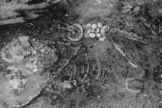
[image error] English archaeologist and Egyptologist Guy Brunton (1878-1948) is credited with discovering the Badarian culture, which flourished in Upper Egypt between 4400 B.C. and 4000 B.C., long before the pyramids were built and the pharaohs came into power. Shown here is a Badarian grave, excavated by Brunton.
English archaeologist and Egyptologist Guy Brunton (1878-1948) is credited with discovering the Badarian culture, which flourished in Upper Egypt between 4400 B.C. and 4000 B.C., long before the pyramids were built and the pharaohs came into power. Shown here is a Badarian grave, excavated by Brunton.
Credit: G. Brunton, Mostagedda and the Tasian Culture (London 1937) Pl. VI.
View full size image"There was some discomfort with dead bodies, quite frankly, and so we don't actually know for sure where the bodies are," Buckley said.
While perhaps squeamish about the dead, British archaeologists who dug up ancient sites in Egypt during the early 20th century were interested in textiles.
"What happened was the textiles from the bodies were recovered and taken to the Bolton Museum in the northwest of England because of the local interest in textiles," Buckley explained. But knowing Egyptology, he said he wouldn't be surprised if the bodies turned up in storage somewhere.
Though Egyptologists have since embraced the study of bones and soft tissue, Buckley said the field remains quite conservative, and stuck on a date of about 2600 B.C. for the origins of mummification. The new research pushes back the start of intentional mummy making by about 1,500 years.
But Stevenson noted, as did the authors of the paper, that other archaeologists have been turning up evidence that challenges this date in recent years. For example, excavations at the site of Hierakonpolis have revealed resin-soaked linens on bodies dating back to the fourth millennium B.C. Stevenson said she wasn't entirely surprised to learn that prehistoric communities were similarly attentive to the bodies of the deceased.
"Badarian graves are notable in the Egyptian archaeological record for the array of material brought together through expansive networks of exchange, and in these burials are amongst the earliest evidence in Egypt for elaborate body ornamentation," Stevenson told Live Science in an email. "So this fits in very well with that cultural picture."
But, remarkably, this is the first study "to demonstrate the presence of resin-soaked linen a few centuries earlier than was previously attested," Stevenson said, and it is "important to have this scientific confirmation of the 'recipes.'"
http://www.livescience.com/47335-oldest-egyptian-mummy-making.html


 This resin-saturated flax yarn came from a late Neolithic burial wrapping, found at a grave in Upper Egypt. The sample is now kept at the Bolton Museum in England.
This resin-saturated flax yarn came from a late Neolithic burial wrapping, found at a grave in Upper Egypt. The sample is now kept at the Bolton Museum in England.Credit: © Ron Oldfield and Jana Jones
Three thousand years before King Tut's body was brushed with embalming oils and wrapped in linen to rest in a gold-filled tomb, prehistoric Egyptians seeking immortality may have experimented with their own recipes to preserve the dead for the afterlife.
Scientists previously thought that mummy making began in Egypt around 2600 B.C., during the era when the pyramids of Giza were built, known as the Old Kingdom. But now scientists say they have found traces of complex embalming agents on much older bits of burial shrouds that had been sitting in a museum for nearly 100 years after they were dug up along the Nile Valley.
The newly examined linens were peeled from bodies buried at the Egyptian sites known as Badari and Mostagedda during the Late Neolithic and Predynastic periods, between 4500 B.C. and 3100 B.C. Archaeologists first found these pit graves during a British expedition to the region in the 1920s, and researchers had previously assumed that the hot, dry desert sand naturally mummified any well-preserved corpses from this era.
The harsh environment definitely encouraged preservation, and may have even inspired mummification practices in the first place. But the new research, detailed today (Aug. 13) in the journal PLOS ONE, suggests Egyptians at that time were cooking up embalming mixtures made from animal fats, as well as tree resins and plant extracts that contained powerful antibacterial elements.
The study "highlights the enormous potential of museum collections accumulated a century ago for giving us new insights into the ancient past," said Alice Stevenson, curator of University College London's Petrie Museum of Egyptian Archaeology, who was not involved in the study.
Recipe for death
Study leader Jana Jones of Macquarie University in Sydney, Australia, and colleagues examined about 50 samples from prehistoric mummy wrappings, mostly taken from tombs at Mostagedda in modern-day Egypt's Asyuti Province. Archaeologists had often noted these textiles, now housed at England's Bolton Museum, looked suspiciously waxy, as if they were covered in resin, said study researcher Stephen Buckley, an archaeological chemist at the University of York in England.
"I thought there may actually be something here," Buckley told Live Science. "I also knew you couldn't tell by looking, because sometimes bodies can produce shiny substances depending on the context they're in. There was very tentative evidence that there might be something interesting there, but not exactly what it was."
These shiny substances were indeed artificial, a chemical analysis showed. In most cases, the recipe consisted of about three-quarters animal fat or oil, mixed with a small amount of pine resin, aromatic plant extract, a sugar or plant gum, and a natural petroleum. The team found chemical signatures of heating, suggesting these substances had been processed in antiquity.
"It was a recipe that was relatively consistent [across all samples], and it was the same recipe, essentially, that was being used later in pharaonic, classical Egyptian mummification," Buckley said.
The tree resin and aromatic plant extract, in particular, have powerful antibacterial properties. Though these elements wouldn't have entirely stopped the decay of the body, they would have at least stopped bacteria from flourishing, Buckley said.
The embalming ingredients also suggest that these prehistoric people had a wide trade network. Some of the compounds were imported far from the heart of Egypt, including the pine resin, which came from southeastern Anatolia, in modern-day Turkey, Buckley said.
Eternal life
Prehistoric Egyptians didn't leave behind embalming manuals or treatises about their views on the afterlife like their descendants did. But these early attempts at mummification may have been the seeds of the Egyptian idea that immortality required the body's preservation, Buckley said. [See Images of Egyptian Mummification Process]
Artificial mummification isn't unique to Egypt. The oldest mummy-making society was the Chinchorro culture in northern Chile and Peru, which has mummies that date back to 6000 B.C. Buckley said it's interesting that most cultures that practiced mummification lived in dry, desert climates, where bodies would be preserved naturally to some extent. He suspects people in these regions may have connected natural body preservation with cheating death, and may have later developed salves to aid in that process.
In Egypt, the choice of embalming agents might have been accidental at first.
"What makes most sense is perhaps these ingredients were chosen for their symbolic significance initially," Buckley said. For example, the team discovered traces of a chemical that's found only in sea sponges in the Mediterranean. These regenerative animals may have held some symbolic significance related to rebirth.
"They likely noticed that there was some soft-tissue preservation," Buckley said. "And from that, they recognized that these embalming agents were helpful to preserve the body, and if you can preserve the body, you can perhaps cheat death and survive into the next life. That was the late-Egyptian mindset, and it seems [earlier cultures] were already thinking on those sorts of lines."
Mummies without bodies
Unfortunately, the bodies that were once wrapped in these linens have been lost. At the time these finds were excavated, British archaeologists were more interested in the artifacts — the pots, jewels, shells and other goods placed in the graves. [Photos: Image Gallery: The Faces of Egyptian Mummies Revealed]

[image error]
 English archaeologist and Egyptologist Guy Brunton (1878-1948) is credited with discovering the Badarian culture, which flourished in Upper Egypt between 4400 B.C. and 4000 B.C., long before the pyramids were built and the pharaohs came into power. Shown here is a Badarian grave, excavated by Brunton.
English archaeologist and Egyptologist Guy Brunton (1878-1948) is credited with discovering the Badarian culture, which flourished in Upper Egypt between 4400 B.C. and 4000 B.C., long before the pyramids were built and the pharaohs came into power. Shown here is a Badarian grave, excavated by Brunton.Credit: G. Brunton, Mostagedda and the Tasian Culture (London 1937) Pl. VI.
View full size image"There was some discomfort with dead bodies, quite frankly, and so we don't actually know for sure where the bodies are," Buckley said.
While perhaps squeamish about the dead, British archaeologists who dug up ancient sites in Egypt during the early 20th century were interested in textiles.
"What happened was the textiles from the bodies were recovered and taken to the Bolton Museum in the northwest of England because of the local interest in textiles," Buckley explained. But knowing Egyptology, he said he wouldn't be surprised if the bodies turned up in storage somewhere.
Though Egyptologists have since embraced the study of bones and soft tissue, Buckley said the field remains quite conservative, and stuck on a date of about 2600 B.C. for the origins of mummification. The new research pushes back the start of intentional mummy making by about 1,500 years.
But Stevenson noted, as did the authors of the paper, that other archaeologists have been turning up evidence that challenges this date in recent years. For example, excavations at the site of Hierakonpolis have revealed resin-soaked linens on bodies dating back to the fourth millennium B.C. Stevenson said she wasn't entirely surprised to learn that prehistoric communities were similarly attentive to the bodies of the deceased.
"Badarian graves are notable in the Egyptian archaeological record for the array of material brought together through expansive networks of exchange, and in these burials are amongst the earliest evidence in Egypt for elaborate body ornamentation," Stevenson told Live Science in an email. "So this fits in very well with that cultural picture."
But, remarkably, this is the first study "to demonstrate the presence of resin-soaked linen a few centuries earlier than was previously attested," Stevenson said, and it is "important to have this scientific confirmation of the 'recipes.'"
http://www.livescience.com/47335-oldest-egyptian-mummy-making.html

Published on August 14, 2014 16:01
History Trivia - Duncan, King of Scots murdered by Macbeth
August 14

1040 Duncan, King of Scots was murdered by Macbeth, who became king.
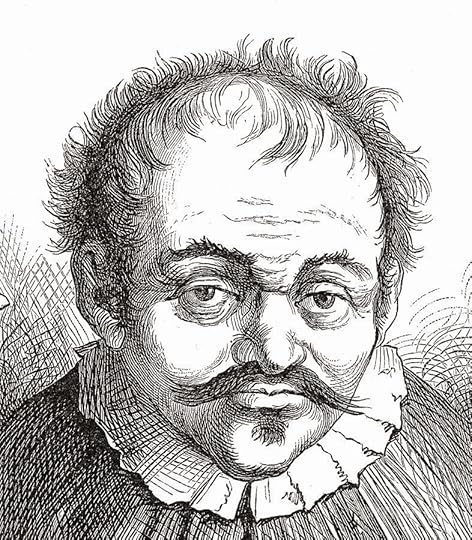
1457 The first book ever printed was published by a German astrologer named Faust. He was thrown in jail while trying to sell books in Paris because authorities concluded that all the identical books meant Faust had dealt with the devil.
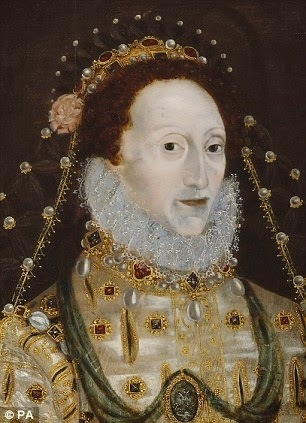
1585 England's Queen Elizabeth I refused sovereignty of the Netherlands.

1598 Nine Years War: Battle of the Yellow Ford: Irish forces under Hugh O'Neill, Earl of Tyrone, defeated an English expeditionary force under Henry Bagenal.


1040 Duncan, King of Scots was murdered by Macbeth, who became king.

1457 The first book ever printed was published by a German astrologer named Faust. He was thrown in jail while trying to sell books in Paris because authorities concluded that all the identical books meant Faust had dealt with the devil.

1585 England's Queen Elizabeth I refused sovereignty of the Netherlands.

1598 Nine Years War: Battle of the Yellow Ford: Irish forces under Hugh O'Neill, Earl of Tyrone, defeated an English expeditionary force under Henry Bagenal.

Published on August 14, 2014 04:35
August 13, 2014
History Trivia - Henry V of England army lands on mouth of the Seine River, and organizes the siege of the town of Harfleur
August 13
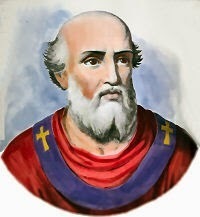
523 John I was elected Roman Catholic pope. He ended the Acacian Schism, bringing reunification of the Eastern and Western churches by restoring peace between the papacy and the Byzantine Emperor Justin I. He also set the rules for the Alexandrian calendar computation of the date of Easter, which was eventually accepted throughout the West.
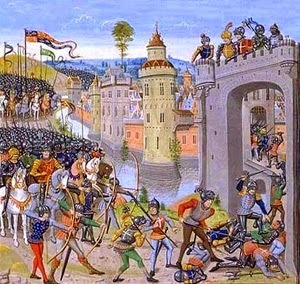
1415 Hundred Years War: King Henry V of England army landed on mouth of the Seine River, and organized the siege of the town of Harfleur (now part of Le Havre).
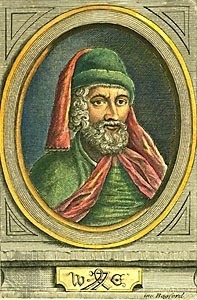
1422 William Caxton, first English printer, was born. 1
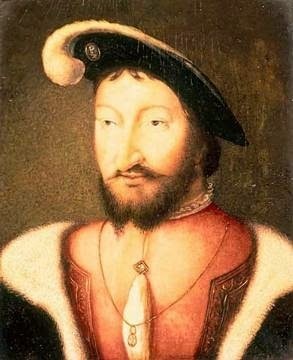 Francis I of France
Francis I of France
516 The Treaty of Noyon between France and Spain was signed. Francis I of France recognized Charles's claim to Naples, and Charles V, Holy Roman Emperor recognized Francis' claim to Milan.


523 John I was elected Roman Catholic pope. He ended the Acacian Schism, bringing reunification of the Eastern and Western churches by restoring peace between the papacy and the Byzantine Emperor Justin I. He also set the rules for the Alexandrian calendar computation of the date of Easter, which was eventually accepted throughout the West.

1415 Hundred Years War: King Henry V of England army landed on mouth of the Seine River, and organized the siege of the town of Harfleur (now part of Le Havre).

1422 William Caxton, first English printer, was born. 1
 Francis I of France
Francis I of France 516 The Treaty of Noyon between France and Spain was signed. Francis I of France recognized Charles's claim to Naples, and Charles V, Holy Roman Emperor recognized Francis' claim to Milan.

Published on August 13, 2014 05:26
August 12, 2014
Announcement Hank of Twin Rivers, Book Two: The Eagle's Nest
Announcement Hank of Twin Rivers, Book Two: The Eagle's Nest
HEADS UP!
 Coming in August The second book of the Hank of Twin Rivers Series
Coming in August The second book of the Hank of Twin Rivers Series

Historically correct, this 1855 series takes readers into the exciting and dangerous life of Hank Heaton and his journey from a shy twelve year old lad to a bronco busting, horse wrangler at eighteen.
Read the first chapter of Book Two here.
Chapter One
View From the Eagles Nest
Hank scratched at the mosquito bite on his elbow. He knew scratching just made it worse but it itched like the devil. He had scabs all up and down his arms. He would be glad when the first frost came to free the area of the pesky insects. It seemed they weren’t so thick in his perch in the top of the tall cottonwood tree, a place he called his eagle’s nest.
He thought about his birthday coming in September. Not that it mattered much. Birthdays were for little boys who had mothers to bake cakes for them, not for the likes of him. Sixteen years weren’t anything to celebrate anyway. Pa kept reminding him he was just a kid. “You’re still wet behind the ears.” seemed to be his favorite saying.
Lately though things were going good between him and Pa. It hadn’t always been that way. After Ma and his baby sister, Amanda, died of cholera Pa had turned cold and distant. Uncle Mac said it was because Pa sorrowed so. Hank handled his own sorrow by keeping Ma’s memory fresh in his mind. He touched the ring tied on the string around his neck, Ma’s wedding ring, the only thing he had to remember her by. He considered it his lucky piece.
The colors of the early sunset reflected in the waters of the merging Platte Rivers as they flowed eastward to the great Missouri. He wished he were an artist and could draw a picture of the fall colored leaves of maples, cottonwood, and willow trees that lined the steep cliffs separating the settlement from the valley. He grinned at the thought. Pa wouldn’t approve of him spending time painting pictures. As it was, he complained about the time he spent in reading. It was only through Uncle Mac’s interference that Pa had allowed him to finish eighth grade back in Buck Creek.
The bawling of Hank’s pet cow, Clementine, sounded loud across the water. She and her newest calf grazed in the lower pasture between the rivers, swishing their tails to ward off flies. Trouble, her three year-old calf, now grown to be a fine bull, grazed nearby. Below on the river’s bank Uncle Mac fished for catfish or bullheads, whichever were biting. Hank hoped it was catfish. There was nothing better than Uncle Mac’s cornmeal coated fried catfish. “’Tis a meal fit for a king,” Uncle Mac bragged.
Dotted with sagebrush, the Nebraska prairie, stretched above both sides of the valley as far as he could see. During the summer months, wagon trains rolled from sun up to sun down on trails deeply rutted by thousands of wagon wheels. The Mormon Trail on the north of the Platte valley, and the Oregon Trail on the south led to new land in far away places like Oregon and California. Hank often wondered what the travelers found in these places, free land for growing crops or the gold in California? Hank thanked his lucky stars that when Pa decided to leave Buck Creek he hadn’t headed to Oregon or California. All the land they needed was right here in Nebraska.
He looked at his town, the Twin Rivers settlement on the north bluff. Three years ago when they settled in the Platte Valley he had had the privilege of naming their new home where Pa and Pa’s partner, Major Grant Beams, decided to set up a trading post. With the two Platte Rivers merging together, ‘Twin Rivers’ came to his mind. “Good name, Sonny,” the Major had praised. Pa and Uncle Mac had agreed.
Late sunlight reflected from the new glass windows replacing the thin oiled paper in their sod house He and Uncle Mac had built this house when they first came to the Platte Valley. Uncle Mac called it the bachelor house since only men lived in it. The privy, a place where they could do their business in privacy, stood near the chicken coop.
Wagon trains, following both trails, stopped for supplies, and Pa’s business grew. While he and Major Beams traveled back and forth to Council Bluffs to buy merchandise, Hank helped Uncle Mac plant the crops, take care of the animals, and harvest the trees from the land his uncle had claimed in the valley.
The prairie town had grown from this sod house and a lean-to barn into a main street consisting of Pa’s store/warehouse, a livery station, a blacksmith, and the newest establishment, a barbershop/bath/shoe store. On his last trip to Omaha, Pa had brought back two Chinese brothers, Chung Lee and Chung Yao. Chung Lee was a barber and his brother a cobbler. They lived in a small room in the back of the shop.
He watched Uncle Mac’s friend, Johnny Kelly, ride into the livery station where he worked. Recently from Texas, Johnny had been one of those passing through who decided to stay. Pa put him to work managing the livery stable. With his ten-gallon hat, cowboy boots, and his gun holster tied to his right thigh, he looked like a real cowboy. Johnny was Hank’s hero, a true wrangler, said to be the best in the west at breaking broncos.
A voice interrupted his thoughts. “Hank are you up there?” Hank smiled at the sound of Becca Twiddle’s voice. Preacher Zeckariah Twiddle, his wife, and their nine children had been the first ones to settle near Twin Rivers. Their oldest child, Becca, became Hank’s special friend. He could tell her his thoughts that he would tell no one else, not even Uncle Mac.
“Come on up,” he called, “it’s cooler up here.” He watched her freckled face break through the thin leaf cover.
Pulling herself up on the branch beside Hank she pushed the stray wisps of red-blonde curls from her forehead. “I can’t stay long. If Papa finds me with you, he’ll tan my hide. I told him I was going to gather chokecherries.” She looked down at her bare feet perched on the branch below. “I wish he wasn’t so grumpy.”
“Maybe he will change. Pa did. I thought he hated me until I got the sunstroke. When he thought I was gonna die he changed.”
Becca shook her head. “Papa will never change. He thinks he’s God’s voice and everyone has to listen to him.” She sighed. “Did I tell you Mama is going to have another baby? She keeps having them, and I keep having to take care of them. I wish I’d been born a boy.”
“I’m glad you weren’t.” Hank teasingly tugged on her braid.
Embarrassed, Becca changed the subject. “The crickets sure are loud.”
“Uncle Mac says that the louder the crickets chirp the hotter it is. It must be near to one hundred degrees.”
“It’ll be cooling down now that September is almost here.” They sat in silence as the sun lowered in the sky. After a summer of little rain, the river flowed sluggishly around large sand bars. Below Uncle Mac threw out his line again whistling an Irish tune.
Becca looked out over the valley. “There are still a lot of dead trees along the river bank.”
Hank nodded. “The flood that came through two springs ago did that. It almost got me too.” He didn’t tell her how he had panicked and fell off Blaze, their horse, when he saw the large wall of water coming toward him. He still felt embarrassed thinking about it.
“How come this tree didn’t get torn down, I wonder.”
Hank grinned and winked at her. “Luck of the Irish, I guess.”
“I’m glad you share it with me. It is so peaceful here.”
“I know.” He reached over and took her hand. He felt peaceful here with her. She hadn’t always been peaceful, though. When they first met he took her for a boy. She was wearing overalls with her pigtails tucked up in an old straw hat. It was easier for her to wear her brother’s clothes since she had to drive one of the wagons her parents had brought from Missouri. That upset her, and she had shoved him down. After that, she had ignored him, even when he tried to make amends. But that first summer when she heard that he was sick from the heat she brought him some of her special chicken soup. From then on they had become best friends. Hank couldn’t imagine life without her.
Becca reached her foot to the branch below. “It’s getting late and I gotta pick those chokecherries and get back before Papa misses me. If he catches me with you, I won’t be the only one to be in trouble. He’ll blame Mama for not watching me closer.”
Hank frowned. “I don’t know why he hates me so. Maybe it‘s because he doesn’t like Uncle Mac. Uncle Mac doesn’t have much use for him either, and he isn’t shy about saying it. Will I see you later?”
“Maybe after Sunday meeting when Papa is off on one of his preaching trips you can come over. Ma likes you.” She slid her foot on the next branch and continued to climb down. Just as she stepped on the ground and picked up her basket, an unearthly moan sounded across the valley.
~~~~~~~~~~~~~~~~~~HAVEN'T READ THE FIRST HANK BOOK?Why and how did Hank and his family get to Twin Rivers?
What dangers did he meet along the Oregon Trail? Who did he meet on the way to share the dangers on the Nebraska Prairie?
How did Hank meet Becca?

Twelve year old Hank's lack of self esteem makes him believe that Pa hates him. But what can he do about it? He can't make himself grow taller, and now that the cholera has weakened his leg and he finds himself limping, he feels even more inadequate. The disease took away his mother so he doesn't have her to comfort him .. to be "coddled" as Pa calls it. His only comfort is his pet cow, Clementine, and Ma's brother, Uncle Mac. Plagued by the Monster Goose, who nips his butt whenever it gets close to him, and his fear of Pa's disappointment on him, he hides in daydreaming and book reading. When Pa decides to homestead on land in western Nebraska, Hank rebels. Pa’s discipline is quick and painful and Hank has to obey. They follow the wild Platte River on the Oregon Trail crossing rattlesnake infested prairies, fording raging rivers, and eating dust while walking behind the slow wagon. He withstands the unpredictable mid-western weather of hailstorms, dust storms, an early blizzard and flash floods. Stampeding buffalo, murdering claim jumpers, unfriendly Indian Tribes forces him to face life on the wild frontierland.
GET IT NOWYou can get Hank of Twin Rivers; Book one, Journey of Change at these links.
E-book at Smashwords.com: http://www.smashwords.com/books/view/336710E-book at Amazon.com: http://www.amazon.com/dp/B00E7NKYSYPrint book: http://www.amazon.com/Hank-Twin-Rivers-Book-One/dp/1494427001/
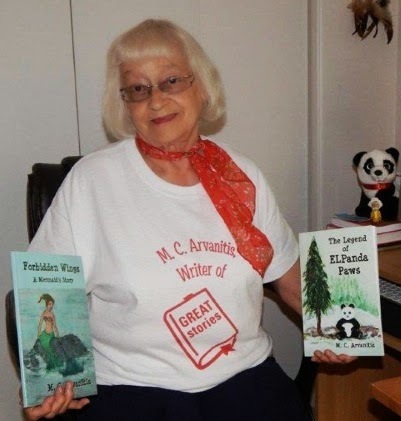
Check out my Mid-Grade fantasy series.
Authors Amazon page. http://www.amazon.com/M.C.-Arvanitis/e/B007UJWLC4/ http://mcarvanitiswriter.blogspot.com/2014/08/announcement-hank-of-twin-rivers-book.html?utm_source=feedburner&utm_medium=feed&utm_campaign=Feed%3A+MCArvanitisWriter%2FWordsTogetherMakeTales+%28M.+C.+Arvanitis%2C+writer+%2F+WORDS+TOGETHER+MAKE+TALES%29
HEADS UP!
 Coming in August The second book of the Hank of Twin Rivers Series
Coming in August The second book of the Hank of Twin Rivers Series

Historically correct, this 1855 series takes readers into the exciting and dangerous life of Hank Heaton and his journey from a shy twelve year old lad to a bronco busting, horse wrangler at eighteen.
Read the first chapter of Book Two here.
Chapter One
View From the Eagles Nest
Hank scratched at the mosquito bite on his elbow. He knew scratching just made it worse but it itched like the devil. He had scabs all up and down his arms. He would be glad when the first frost came to free the area of the pesky insects. It seemed they weren’t so thick in his perch in the top of the tall cottonwood tree, a place he called his eagle’s nest.
He thought about his birthday coming in September. Not that it mattered much. Birthdays were for little boys who had mothers to bake cakes for them, not for the likes of him. Sixteen years weren’t anything to celebrate anyway. Pa kept reminding him he was just a kid. “You’re still wet behind the ears.” seemed to be his favorite saying.
Lately though things were going good between him and Pa. It hadn’t always been that way. After Ma and his baby sister, Amanda, died of cholera Pa had turned cold and distant. Uncle Mac said it was because Pa sorrowed so. Hank handled his own sorrow by keeping Ma’s memory fresh in his mind. He touched the ring tied on the string around his neck, Ma’s wedding ring, the only thing he had to remember her by. He considered it his lucky piece.
The colors of the early sunset reflected in the waters of the merging Platte Rivers as they flowed eastward to the great Missouri. He wished he were an artist and could draw a picture of the fall colored leaves of maples, cottonwood, and willow trees that lined the steep cliffs separating the settlement from the valley. He grinned at the thought. Pa wouldn’t approve of him spending time painting pictures. As it was, he complained about the time he spent in reading. It was only through Uncle Mac’s interference that Pa had allowed him to finish eighth grade back in Buck Creek.
The bawling of Hank’s pet cow, Clementine, sounded loud across the water. She and her newest calf grazed in the lower pasture between the rivers, swishing their tails to ward off flies. Trouble, her three year-old calf, now grown to be a fine bull, grazed nearby. Below on the river’s bank Uncle Mac fished for catfish or bullheads, whichever were biting. Hank hoped it was catfish. There was nothing better than Uncle Mac’s cornmeal coated fried catfish. “’Tis a meal fit for a king,” Uncle Mac bragged.
Dotted with sagebrush, the Nebraska prairie, stretched above both sides of the valley as far as he could see. During the summer months, wagon trains rolled from sun up to sun down on trails deeply rutted by thousands of wagon wheels. The Mormon Trail on the north of the Platte valley, and the Oregon Trail on the south led to new land in far away places like Oregon and California. Hank often wondered what the travelers found in these places, free land for growing crops or the gold in California? Hank thanked his lucky stars that when Pa decided to leave Buck Creek he hadn’t headed to Oregon or California. All the land they needed was right here in Nebraska.
He looked at his town, the Twin Rivers settlement on the north bluff. Three years ago when they settled in the Platte Valley he had had the privilege of naming their new home where Pa and Pa’s partner, Major Grant Beams, decided to set up a trading post. With the two Platte Rivers merging together, ‘Twin Rivers’ came to his mind. “Good name, Sonny,” the Major had praised. Pa and Uncle Mac had agreed.
Late sunlight reflected from the new glass windows replacing the thin oiled paper in their sod house He and Uncle Mac had built this house when they first came to the Platte Valley. Uncle Mac called it the bachelor house since only men lived in it. The privy, a place where they could do their business in privacy, stood near the chicken coop.
Wagon trains, following both trails, stopped for supplies, and Pa’s business grew. While he and Major Beams traveled back and forth to Council Bluffs to buy merchandise, Hank helped Uncle Mac plant the crops, take care of the animals, and harvest the trees from the land his uncle had claimed in the valley.
The prairie town had grown from this sod house and a lean-to barn into a main street consisting of Pa’s store/warehouse, a livery station, a blacksmith, and the newest establishment, a barbershop/bath/shoe store. On his last trip to Omaha, Pa had brought back two Chinese brothers, Chung Lee and Chung Yao. Chung Lee was a barber and his brother a cobbler. They lived in a small room in the back of the shop.
He watched Uncle Mac’s friend, Johnny Kelly, ride into the livery station where he worked. Recently from Texas, Johnny had been one of those passing through who decided to stay. Pa put him to work managing the livery stable. With his ten-gallon hat, cowboy boots, and his gun holster tied to his right thigh, he looked like a real cowboy. Johnny was Hank’s hero, a true wrangler, said to be the best in the west at breaking broncos.
A voice interrupted his thoughts. “Hank are you up there?” Hank smiled at the sound of Becca Twiddle’s voice. Preacher Zeckariah Twiddle, his wife, and their nine children had been the first ones to settle near Twin Rivers. Their oldest child, Becca, became Hank’s special friend. He could tell her his thoughts that he would tell no one else, not even Uncle Mac.
“Come on up,” he called, “it’s cooler up here.” He watched her freckled face break through the thin leaf cover.
Pulling herself up on the branch beside Hank she pushed the stray wisps of red-blonde curls from her forehead. “I can’t stay long. If Papa finds me with you, he’ll tan my hide. I told him I was going to gather chokecherries.” She looked down at her bare feet perched on the branch below. “I wish he wasn’t so grumpy.”
“Maybe he will change. Pa did. I thought he hated me until I got the sunstroke. When he thought I was gonna die he changed.”
Becca shook her head. “Papa will never change. He thinks he’s God’s voice and everyone has to listen to him.” She sighed. “Did I tell you Mama is going to have another baby? She keeps having them, and I keep having to take care of them. I wish I’d been born a boy.”
“I’m glad you weren’t.” Hank teasingly tugged on her braid.
Embarrassed, Becca changed the subject. “The crickets sure are loud.”
“Uncle Mac says that the louder the crickets chirp the hotter it is. It must be near to one hundred degrees.”
“It’ll be cooling down now that September is almost here.” They sat in silence as the sun lowered in the sky. After a summer of little rain, the river flowed sluggishly around large sand bars. Below Uncle Mac threw out his line again whistling an Irish tune.
Becca looked out over the valley. “There are still a lot of dead trees along the river bank.”
Hank nodded. “The flood that came through two springs ago did that. It almost got me too.” He didn’t tell her how he had panicked and fell off Blaze, their horse, when he saw the large wall of water coming toward him. He still felt embarrassed thinking about it.
“How come this tree didn’t get torn down, I wonder.”
Hank grinned and winked at her. “Luck of the Irish, I guess.”
“I’m glad you share it with me. It is so peaceful here.”
“I know.” He reached over and took her hand. He felt peaceful here with her. She hadn’t always been peaceful, though. When they first met he took her for a boy. She was wearing overalls with her pigtails tucked up in an old straw hat. It was easier for her to wear her brother’s clothes since she had to drive one of the wagons her parents had brought from Missouri. That upset her, and she had shoved him down. After that, she had ignored him, even when he tried to make amends. But that first summer when she heard that he was sick from the heat she brought him some of her special chicken soup. From then on they had become best friends. Hank couldn’t imagine life without her.
Becca reached her foot to the branch below. “It’s getting late and I gotta pick those chokecherries and get back before Papa misses me. If he catches me with you, I won’t be the only one to be in trouble. He’ll blame Mama for not watching me closer.”
Hank frowned. “I don’t know why he hates me so. Maybe it‘s because he doesn’t like Uncle Mac. Uncle Mac doesn’t have much use for him either, and he isn’t shy about saying it. Will I see you later?”
“Maybe after Sunday meeting when Papa is off on one of his preaching trips you can come over. Ma likes you.” She slid her foot on the next branch and continued to climb down. Just as she stepped on the ground and picked up her basket, an unearthly moan sounded across the valley.
~~~~~~~~~~~~~~~~~~HAVEN'T READ THE FIRST HANK BOOK?Why and how did Hank and his family get to Twin Rivers?
What dangers did he meet along the Oregon Trail? Who did he meet on the way to share the dangers on the Nebraska Prairie?
How did Hank meet Becca?

Twelve year old Hank's lack of self esteem makes him believe that Pa hates him. But what can he do about it? He can't make himself grow taller, and now that the cholera has weakened his leg and he finds himself limping, he feels even more inadequate. The disease took away his mother so he doesn't have her to comfort him .. to be "coddled" as Pa calls it. His only comfort is his pet cow, Clementine, and Ma's brother, Uncle Mac. Plagued by the Monster Goose, who nips his butt whenever it gets close to him, and his fear of Pa's disappointment on him, he hides in daydreaming and book reading. When Pa decides to homestead on land in western Nebraska, Hank rebels. Pa’s discipline is quick and painful and Hank has to obey. They follow the wild Platte River on the Oregon Trail crossing rattlesnake infested prairies, fording raging rivers, and eating dust while walking behind the slow wagon. He withstands the unpredictable mid-western weather of hailstorms, dust storms, an early blizzard and flash floods. Stampeding buffalo, murdering claim jumpers, unfriendly Indian Tribes forces him to face life on the wild frontierland.
GET IT NOWYou can get Hank of Twin Rivers; Book one, Journey of Change at these links.
E-book at Smashwords.com: http://www.smashwords.com/books/view/336710E-book at Amazon.com: http://www.amazon.com/dp/B00E7NKYSYPrint book: http://www.amazon.com/Hank-Twin-Rivers-Book-One/dp/1494427001/

Check out my Mid-Grade fantasy series.
Authors Amazon page. http://www.amazon.com/M.C.-Arvanitis/e/B007UJWLC4/ http://mcarvanitiswriter.blogspot.com/2014/08/announcement-hank-of-twin-rivers-book.html?utm_source=feedburner&utm_medium=feed&utm_campaign=Feed%3A+MCArvanitisWriter%2FWordsTogetherMakeTales+%28M.+C.+Arvanitis%2C+writer+%2F+WORDS+TOGETHER+MAKE+TALES%29

Published on August 12, 2014 15:18
Entwined by Gladys Quintal available on Amazon
 Adelaide Stone has been in love with the gorgeous Holt - her neighbour - since kindergarten, but he doesn't seem to know she exists. Her low opinion of herself doesn't help matters and neither do the secrets that have entwined their two families since they were kids. Will he ever notice her, take her in his arms and profess his undying love? Or will the skeletons she is about to uncover, crush her dreams forever
Adelaide Stone has been in love with the gorgeous Holt - her neighbour - since kindergarten, but he doesn't seem to know she exists. Her low opinion of herself doesn't help matters and neither do the secrets that have entwined their two families since they were kids. Will he ever notice her, take her in his arms and profess his undying love? Or will the skeletons she is about to uncover, crush her dreams foreverAmazon US
http://www.amazon.com/Entwined-Gladys-Quintal/dp/1499156405
Amazon UK
http://www.amazon.com/Entwined-Gladys-Quintal/dp/1499156405/ref=sr_1_1?ie=UTF8&qid=1407851387&sr=8-1&keywords=entwined+by+gladys+quintal

Published on August 12, 2014 06:50
Diane Turner - London Rocks - 12.08.2014
Published on August 12, 2014 06:18
Mr. Midshipman Easy by Frederick Marryat Narrated by: Sebastian Lockwood - on Kindle, Audible and iTunes
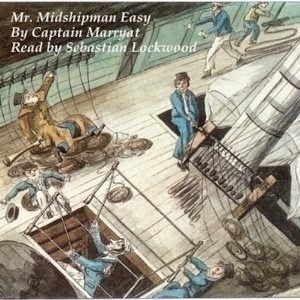 Mr. Midshipman Easy is the 1836 novel by Frederick Marryat, a retired Captain in the 19th century Royal Navy. The novel is set during the Napoleonic Wars, in which Marryat himself served with distinction. It was adapted twice into films in 1916 and in 1935 as Midshipman Easy. Captain Frederick Marryat (July 10, 1792 - August 9, 1848) was an English Royal Navy officer, novelist, and a contemporary and acquaintance of Charles Dickens, noted today as an early pioneer of the sea story. Kindlehttp://www.amazon.com/Mr-Midshipman-Easy/dp/B00FAC6AR0/ref=sr_1_1?s=books&ie=UTF8&qid=1407626423&sr=1-1&keywords=Mr.+Midshipman+Easy+Sebastian+Lockwood Audiblehttp://www.audible.com/pd/Fiction/Mr-Midshipman-Easy-Audiobook/B00F9GKWRQ/ref=a_search_c4_1_2_srTtl?qid=1407626165&sr=1-2#publisher-summary iTuneshttps://itunes.apple.com/us/audiobook/mr.-midshipman-easy-unabridged/id711114979
Mr. Midshipman Easy is the 1836 novel by Frederick Marryat, a retired Captain in the 19th century Royal Navy. The novel is set during the Napoleonic Wars, in which Marryat himself served with distinction. It was adapted twice into films in 1916 and in 1935 as Midshipman Easy. Captain Frederick Marryat (July 10, 1792 - August 9, 1848) was an English Royal Navy officer, novelist, and a contemporary and acquaintance of Charles Dickens, noted today as an early pioneer of the sea story. Kindlehttp://www.amazon.com/Mr-Midshipman-Easy/dp/B00FAC6AR0/ref=sr_1_1?s=books&ie=UTF8&qid=1407626423&sr=1-1&keywords=Mr.+Midshipman+Easy+Sebastian+Lockwood Audiblehttp://www.audible.com/pd/Fiction/Mr-Midshipman-Easy-Audiobook/B00F9GKWRQ/ref=a_search_c4_1_2_srTtl?qid=1407626165&sr=1-2#publisher-summary iTuneshttps://itunes.apple.com/us/audiobook/mr.-midshipman-easy-unabridged/id711114979

Published on August 12, 2014 05:21




